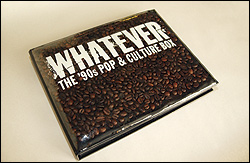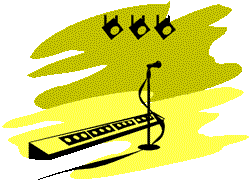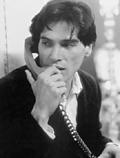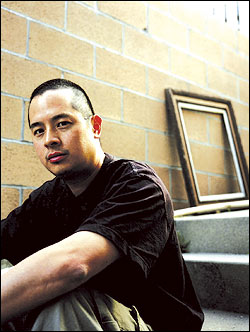There are many ways you can tackle a decade, and with 1998’s Have a Nice Day: The ’70s Pop Culture Box and 2002’s Like, Ohmigod! The ’80s Pop Culture Box (Totally), reissue O.G.’s Rhino Records did it by sticking to the Billboard charts. Each box featured seven CDs, a thick booklet with essays and a timeline, and covers made from a period-identified substance—shag carpet for the ’70s, rubberized color plastic for the ’80s. They also got on the nerves of Cory Frye, the timeline author of the ’80s box: “I’ve always felt that [pop culture–centric] approach was unfairly mean-spirited and cruel, curdled in a deluded sense of self-sophistication: Remember all that stupid shit we used to like?“
Frye’s and co-producer John Srebalus’ solution is the new Whatever: The ’90s Pop & Culture Box (Rhino), whose cover is printed on a bag of coffee beans and whose booklet is the source of Frye’s quote. But as solutions go, it’s awfully compromised. Despite Srebalus’ liner-note vow to not “merely condense a stack of Billboard charts into a list of 130 songs,” that’s precisely what the bulk of the collection does. The material here that didn’t chart in some way fills slightly more than a single CD; add in stuff that got minor chart action but couldn’t reasonably be termed “hits,” like De La Soul’s “Itszoweezee (Hot)” (disc seven), which went to No. 60 R&B and No. 113 pop, and you could fill out a second CD. This is a sound idea: If any decade proved that the margins matter as much or more than the center, the ’90s did. What grates about Whatever is how narrow its idea of those margins is.
The word “rockism” has become so over- and misused in the past few months that it’s fast becoming an auto–punch line among people who regularly read about music. This process may have reached its peak last week, when the Philadelphia Weekly‘s Jonathan Valania penned a misguided-verging-on-hallucinatory essay in which he smugly declared that he couldn’t possibly be a rockist, because he thinks M.I.A. is “more important” than Bruce Springsteen—the joke being that lauding an artist for their “importance” is pretty much rockism incarnate.
Nevertheless, that’s how Whatever strikes me, and not just because King Rockist himself, the Chicago Sun-Times‘ Jim DeRogatis, penned its musical overview. It begins with the ampersand. If the ’70s and ’80s boxes were out to celebrate pop as culture, the ’90s box’s “Pop & Culture” designation implies a (largely fanciful) separation between “pop”—Whatever‘s hefty cache of radio hits, which cover a fairly broad stylistic range—and “culture,” which seems intended to imply the nonhits here. Not all of the latter are by folks who didn’t have hits, either: For whatever reason, L7 got on with “Shitlist” and not “Pretend We’re Dead,” and a few cuts (Sugar’s “If I Can’t Change Your Mind,” Supergrass’ “Caught by the Fuzz”) made the charts in England. Still others were college-radio hits, which Billboard doesn’t track (though CMJ does). But when only one of the 23 noncharters included here—Guru with N’Dea Davenport’s “Trust Me”—falls outside the confines of a modern-rock radio playlist, you might wonder where the rest of the decade went.
In fact, let’s put it more simply: Any account of the ’90s in which hip-hop’s expansion into a beast every bit as multileveled as “rock,” or electronic dance music’s myriad offshoots, or the increasing presence in the U.S. urban market of Caribbean styles like ragga, soca, and bhangra, or Nashville’s Garth Brooks–led early-decade boom, or even the anti-Nashville-isms of the alt-country brigade essentially didn’t happen is to be viewed with serious suspicion. Or at least with a suspicion, a specific one—that Rhino wound up splicing its usual general hits overview with an aborted ’90s alt sequel to last year’s ’80s college-rock box, Left of the Dial. That would explain the preponderance of Seattle and Olympia artists among the nonhitmakers here (as well as one-time Sub Pop artists like L7, Afghan Whigs, and the Reverend Horton Heat), not to mention the booklet’s Q&A with Sub Pop founder Jonathan Poneman and its essay by Clark Humphrey—and hints that a ’90s alt box would likely have been even more deeply Seattle-centric than this one is already. Starbucks even provided the beans on Whatever‘s cover—simultaneously mocking and benefiting from corporate synergy, a very ’90s maneuver. (There are also several fake corporate logos on the box’s cardboard ring—apparently, these are very ’90s, which is going to surprise the hell out of anyone alive from the 1900s onward.)
In many ways, this is too bad, because a set that focused on one or the other would likely have hung together a lot better than this one does. Last month, Andrew Unterberger of Stylus posited an alternate hits-only box (containing only 17 percent of what Rhino chose: see www.stylusmagazine.com/feature.php?ID=1699) that reads a lot better than this one does; it’s not difficult to imagine coming up with something similarly good consisting entirely of songs that weren’t hits.
If it’s unfair to judge Whatever against unlicensed, homemade collections like Unterberger’s (and to some degree, it is), the major reason for such conjecture is that the real thing is so disappointing. Whatever seldom settles into anything resembling a groove, nor does it jar in a stimulating way. In his essay, DeRogatis cites Naughty by Nature’s “O.P.P.” or EMF’s “Unbelievable” or Dada’s “Dizz Knee Land” as “slight and ephemeral.” (This is after he assures us that “the best music from the last decade . . . lives on and transcends the time in which it was made.” Ephemeral or long lasting—make up your mind.) But as often as not, these midtempo guitar songs are unbelievably boring—if the idea is to sprinkle some “culture” alongside the “pop,” it pretty much backfires. The sequencing is clunky, frequently grinding to a halt thanks mostly to the midtempo guitar songs. Sure, Collective Soul’s “Shine” is still the worst grunge-era rock hit (Creed came later), but it’s practically an adrenaline shot compared to the eight-and-a-half minutes of Mother Love Bone’s “Chloe Dancer/Crown of Thorns,” which has never sounded more endless than it does here. No wonder everyone in the ’90s started pounding coffee.
Among the great moments and the utter junk on Whatever is the sense of the period it represents having ended before it started—the decade’s back half takes up less than one-third of the box’s running time. That division gets at the split heart of the project, which attempts to tell a specific, Seattle-centric story and concoct a fun overview of an all-over-the-place time, both at once. Unfortunately, it manages neither.








